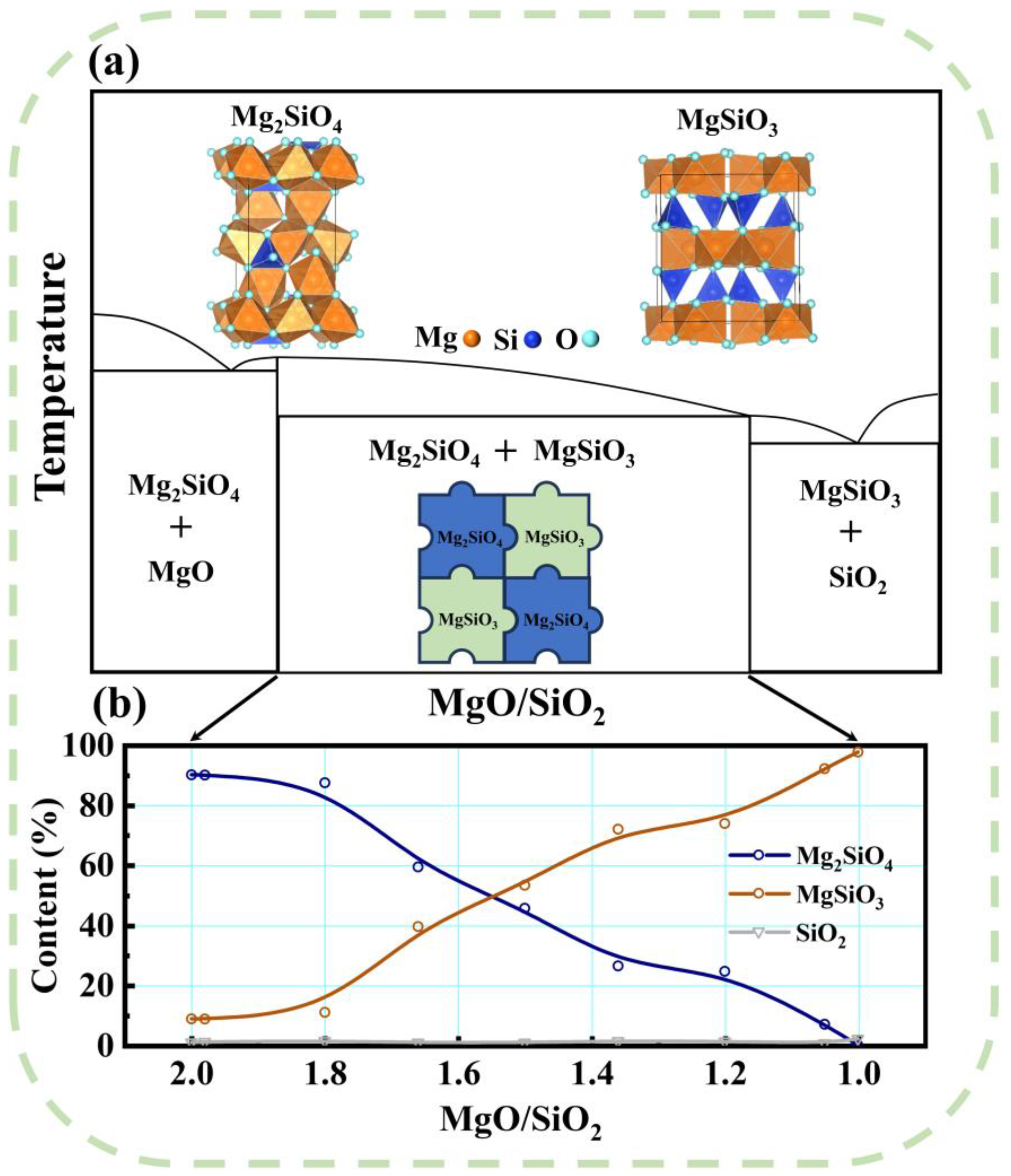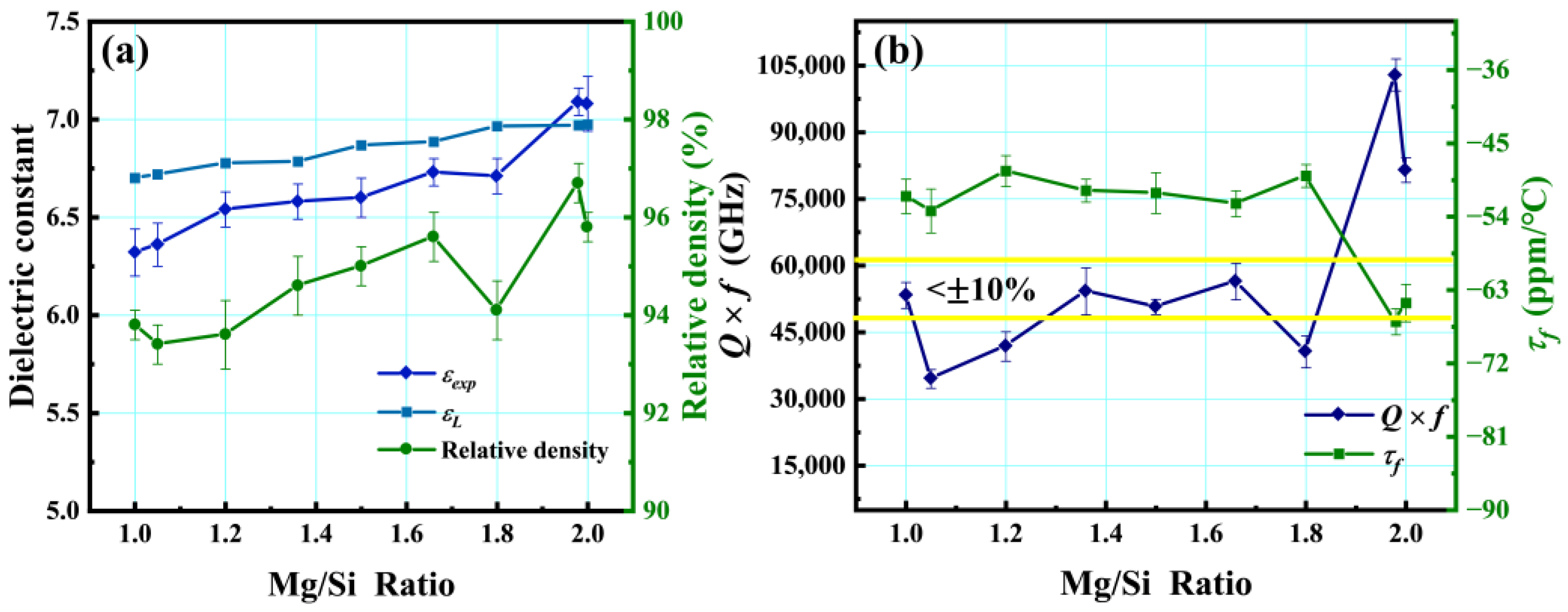Crystal Structure and Microwave Dielectric Property of xMgO-SiO2 (x = 1~2) System for 5G Applications
Abstract
:1. Introduction
2. Materials and Methods
3. Results
4. Conclusions
Author Contributions
Funding
Data Availability Statement
Conflicts of Interest
References
- Dangi, R.; Lalwani, P.; Choudhary, G.; You, I.; Pau, G. Study and Investigation on 5G Technology: A Systematic Review. Sensors 2021, 22, 26. [Google Scholar] [CrossRef] [PubMed]
- Park, J.; Samarakoon, S.; Shiri, H.; Abdel-Aziz, M.K.; Nishio, T.; Elgabli, A.; Bennis, M. Extreme ultra-reliable and low-latency communication. Nat. Electron. 2022, 5, 133–141. [Google Scholar] [CrossRef]
- Shehbaz, M.; Du, C.; Zhou, D.; Xia, S.; Xu, Z. Recent progress in dielectric resonator antenna: Materials, designs, fabrications, and their performance. Appl. Phys. Rev. 2023, 10, 021303. [Google Scholar] [CrossRef]
- Krishna, V.N.; Padmasine, K.G. A review on microwave band pass filters: Materials and design optimization techniques for wireless communication systems. Mater. Sci. Semicond. Process. 2023, 154, 107181. [Google Scholar] [CrossRef]
- Kamutzki, F.; Schneider, S.; Barowski, J.; Gurlo, A.; Hanaor, D.A.H. Silicate dielectric ceramics for millimetre wave applications. J. Eur. Ceram. Soc. 2021, 41, 3879–3894. [Google Scholar] [CrossRef]
- Lou, W.; Mao, M.; Song, K.; Xu, K.; Liu, B.; Li, W.; Yang, B.; Qi, Z.; Zhao, J.; Sun, S.; et al. Low permittivity cordierite-based microwave dielectric ceramics for 5G/6G telecommunications. J. Eur. Ceram. Soc. 2022, 42, 2820–2826. [Google Scholar] [CrossRef]
- Ohsato, H.; Kagomiya, I.; Terada, M.; Kakimoto, K. Origin of improvement of Q based on high symmetry accompanying Si-Al disordering in cordierite millimeter-wave ceramics. J. Eur. Ceram. Soc. 2010, 30, 315–318. [Google Scholar] [CrossRef]
- Yuan, L.; Wang, H.; Lin, H.; Li, W.; Li, X.; Shi, J. Effect of MgO/La2O3 co-doping on the microstructure, transmittance and microwave dielectric properties of translucent polycrystalline alumina. Ceram. Int. 2014, 40, 2109–2113. [Google Scholar] [CrossRef]
- Zhang, K.; Yuan, L.; Fu, Y.; Yuan, C.; Li, W. Microwave dielectric properties of Al2O3 ceramics co-doped with MgO and Nb2O5. J. Mater. Sci. Mater. Electron. 2015, 26, 6526–6531. [Google Scholar] [CrossRef]
- Huang, C.-L.; Wang, J.-J.; Huang, C.-Y. Sintering behavior and microwave dielectric properties of nano alpha-alumina. Mater. Lett. 2005, 59, 3746–3749. [Google Scholar] [CrossRef]
- Alford, N.M.; Penn, S.J. Sintered alumina with low dielectric loss. J. Appl. Phys. 1996, 80, 5895–5898. [Google Scholar] [CrossRef]
- Mage, J.C.; Marcilhac, B.; Gerbaux, X.; Hadni, A. Microwaves properties of MgO single crystals computed from the IR, and measured with a resonator technique. Int. J. Infrared Millim. Waves 1994, 15, 1189–1203. [Google Scholar] [CrossRef]
- Liang, Z.; Li, J.; Wu, J.; Yang, Y.; Lu, B.; Zhang, Y.; Zhang, H. Enhanced microstructure and dielectric properties of low-temperature sintered MgO-xwt%LiF ceramics for high-frequency applications. Ceram. Int. 2022, 48, 2704–2709. [Google Scholar] [CrossRef]
- Krupka, J.; Derzakowski, K.; Tobar, M.; Hartnett, J.; Geyer, R.G. Complex permittivity of some ultralow loss dielectric crystals at cryogenic temperatures. Meas. Sci. Technol. 1999, 10, 387. [Google Scholar] [CrossRef]
- Hu, C.; Liu, P. Preparation and microwave dielectric properties of SiO2 ceramics by aqueous Sol–Gel technique. J. Alloys Compd. 2013, 559, 129–133. [Google Scholar] [CrossRef]
- Fang, Y.; Li, L.; Xiao, Q.; Chen, X.M. Preparation and microwave dielectric properties of cristobalite ceramics. Ceram. Int. 2012, 38, 4511–4515. [Google Scholar] [CrossRef]
- Ohsato, H.; Tsunooka, T.; Sugiyama, T.; Kakimoto, K.-i.; Ogawa, H. Forsterite ceramics for millimeterwave dielectrics. J. Electroceram. 2006, 17, 445–450. [Google Scholar] [CrossRef]
- Nurbaiti, U.; Darminto; Triwikantoro; Zainuri, M.; Pratapa, S. Synthesis and characterization of silica sand-derived nano-forsterite ceramics. Ceram. Int. 2018, 44, 5543–5549. [Google Scholar] [CrossRef]
- Ullah, A.; Liu, H.; Hao, H.; Iqbal, J.; Yao, Z.; Cao, M.; Xu, Q. Phase and Microstructure Evaluation and Microwave Dielectric Properties of Mg1−xNixSiO3 Ceramics. J. Electron. Mater. 2016, 45, 5133–5139. [Google Scholar] [CrossRef]
- Song, K.X.; Chen, X.M.; Fan, X.C. Effects of Mg/Si Ratio on Microwave Dielectric Characteristics of Forsterite Ceramics. J. Am. Ceram. Soc. 2007, 90, 1808–1811. [Google Scholar] [CrossRef]
- He, G.; Li, Z.; Dong, Y.; Wang, G. Effects of excessive magnesium oxide and sintering regime on microstructure and dielectric properties of forsterite ceramics for millimeterwave dielectrics. J. Mater. Sci. Mater. Electron. 2022, 33, 3129–3138. [Google Scholar] [CrossRef]
- Song, M.-E.; Kim, J.-S.; Joung, M.-R.; Nahm, S.; Kim, Y.-S.; Paik, J.-H.; Choi, B.-H. Synthesis and Microwave Dielectric Properties of MgSiO3 Ceramics. J. Am. Ceram. Soc. 2008, 91, 2747–2750. [Google Scholar] [CrossRef]
- Yeon, D.H.; Han, C.S.; Key, S.H.; Kim, H.E.; Cho, Y.S. Physical and Microwave Dielectric Properties of the MgO-SiO2 System. Korean J. Mater. Res. 2009, 19, 550–554. [Google Scholar] [CrossRef]
- Ohi, S.; Osako, T.; Miyake, A. Effects of Grain Size, Cooling Rate, and Sample Preparation on the Phase Transition from Protoenstatite to Clinoenstatite. Can. Mineral. 2022, 60, 405–416. [Google Scholar] [CrossRef]
- Kazakos, A.; Komarneni, S.; Roy, R. Preparation and Densification of Forsterite (Mg2SiO4) by Nanocomposite Sol-Gel Processi-ng. Mater. Lett. 1990, 9, 405–409. [Google Scholar] [CrossRef]
- Brindley, G.W.; Hayami, R. Kinetics and Mechanism of Formation of Forsterite (Mg2SiO4) by Solid State Reaction of MgO and SiO2. Philos. Mag. 1965, 12, 505–514. [Google Scholar] [CrossRef]
- Lai, Y.; Tang, X.; Zhang, H.; Liang, X.; Huang, X.; Li, Y.; Su, H. Correlation between structure and microwave dielectric properties of low-temperature-fired Mg2SiO4 ceramics. Mater. Res. Bull. 2018, 99, 496–502. [Google Scholar] [CrossRef]
- Zhang, L.; Cao, S.; Li, Y.; Jing, R.; Hu, Q.; Tian, Y.; Gu, R.; Kang, J.; Alikin, D.O.; Shur, V.Y.; et al. Achieving ultrahigh energy storage performance over a broad temperature range in (Bi0.5Na0.5)TiO3-based eco-friendly relaxor ferroelectric ceramics via multiple engineering processes. J. Alloys Compd. 2022, 896, 163139. [Google Scholar] [CrossRef]
- Wang, X.; Zhou, S.; Liu, K.; Deng, S.; Xiao, Y.; Chen, X.; Zhou, H. Broad sintering temperature range and stable microwave dielectric properties of Mg2TiO4-CeO2 composite ceramics. Ceram. Int. 2022, 48, 20245–20250. [Google Scholar] [CrossRef]
- Hameed, I.; Li, L.; Liu, X.Q.; Chen, X.M. Ultra low loss (Mg1−xCax)2SiO4 dielectric ceramics (x = 0 to 0.15) for millimeter wave applications. J. Am. Ceram. Soc. 2021, 105, 2010–2019. [Google Scholar] [CrossRef]
- Yan, X.; Liu, Y.; Tang, C.; Liu, S.; Ge, W.; Tong, J.; Meng, F. Microwave dielectric properties of Mg2SiO4-Ca1−ySm2y/3TiO3 composite ceramics. J. Mater. Sci. Mater. Electron. 2022, 33, 19751–19758. [Google Scholar] [CrossRef]
- Zhou, S.; Luan, X.; Hu, S.; Zhou, X.; He, S.; Wang, X.; Zhang, H.; Chen, X.; Zhou, H. Sintering behavior, phase structure and microwave dielectric properties of CeO2 added CaTiO3-SmAlO3 ceramics prepared by reaction sintering method. Ceram. Int. 2021, 47, 3741–3746. [Google Scholar] [CrossRef]
- Zhou, M.F.; Liu, B.; Hu, C.C.; Song, K.X. Ultra-low permittivity MgF2 ceramics with high Qf values and their role as microstrip patch antenna substrates. Ceram. Int. 2023, 49, 369–374. [Google Scholar] [CrossRef]
- Jin, D.H.; Liu, B.; Song, K.X.; Xu, K.W.; Huang, Y.H.; Hu, C.C.; Hu, Y.Y. Boosting densification and microwave dielectric properties in cold sintered BaF2 ceramics for 5.8 GHz WLAN applications. J. Alloys Compd. 2021, 886, 161141. [Google Scholar] [CrossRef]
- Xiang, H.; Kilpijärvi, J.; Myllymäki, S.; Yang, H.; Fang, L.; Jantunen, H. Spinel-olivine microwave dielectric ceramics with low sintering temperature and high quality factor for 5 GHz wi-fi antennas. Appl. Mater. Today 2020, 21, 100826. [Google Scholar] [CrossRef]







Disclaimer/Publisher’s Note: The statements, opinions and data contained in all publications are solely those of the individual author(s) and contributor(s) and not of MDPI and/or the editor(s). MDPI and/or the editor(s) disclaim responsibility for any injury to people or property resulting from any ideas, methods, instructions or products referred to in the content. |
© 2023 by the authors. Licensee MDPI, Basel, Switzerland. This article is an open access article distributed under the terms and conditions of the Creative Commons Attribution (CC BY) license (https://creativecommons.org/licenses/by/4.0/).
Share and Cite
Wang, Y.; Li, J.; Zhu, H.; Wang, Q.; Sun, T.; Ni, T.; Lin, Y.; Liu, Y.; Mao, M.; Hu, J.; et al. Crystal Structure and Microwave Dielectric Property of xMgO-SiO2 (x = 1~2) System for 5G Applications. Crystals 2023, 13, 1296. https://doi.org/10.3390/cryst13091296
Wang Y, Li J, Zhu H, Wang Q, Sun T, Ni T, Lin Y, Liu Y, Mao M, Hu J, et al. Crystal Structure and Microwave Dielectric Property of xMgO-SiO2 (x = 1~2) System for 5G Applications. Crystals. 2023; 13(9):1296. https://doi.org/10.3390/cryst13091296
Chicago/Turabian StyleWang, Yan, Jiajing Li, Haipeng Zhu, Qilei Wang, Tulai Sun, Tao Ni, Yanghong Lin, Yu Liu, Minmin Mao, Ji Hu, and et al. 2023. "Crystal Structure and Microwave Dielectric Property of xMgO-SiO2 (x = 1~2) System for 5G Applications" Crystals 13, no. 9: 1296. https://doi.org/10.3390/cryst13091296





